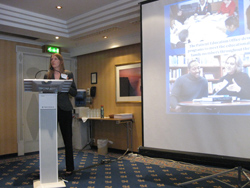Meetings and Events
Spring 2013
Vol. 8, Issue 1
Winter 2013
Vol. 7, Issue 2
Spring 2012
Vol. 7, Issue 1
Spring 2011
Vol. 6, Issue 1
Fall 2011
Vol. 6, Issue 2
Spring 2010
Vol. 5, Issue 1
Fall 2010
Vol. 5, Issue 2
Spring 2009
Vol. 4, Issue 1
Fall 2009
Vol. 4, Issue 2
Spring 2008
Vol. 3, Issue 1
Fall 2008
Vol. 3, Issue 2
Fall 2007
Vol. 2, Issue 2
Winter 2007
Vol. 2, Issue 1
Summer 2006
Vol. 1, Issue 2
Patient Education at International CAM Research Meeting

L-R Lorianne Classen, Anne M. Doherty-Gilman
and K. Simon Yeung
Patient education took center stage as one of only five symposium topics selected for the International Congress on Complementary Medicine Research, which took place May 19-21, 2010, in Tromsø, Norway. The 90-minute symposium was designed to identify best practices in developing cancer patient education materials on the topic of complementary and alternative medicine (CAM).
The “What are Best Practices in Developing Cancer CAM Patient Education Materials?” symposium gathered subject matter experts from three of the top National Cancer Institute designated Cancer Centers in the United States. Symposium panelists included:
- Lorianne Classen, M.P.H., CHES; Senior Health Education Specialist, Patient Education Office, M. D. Anderson Cancer Center (http://www.mdanderson.org/education-and-research/departments-programs-and-labs/programs-centers-institutes/integrative-medicine-program/index.html);
- K. Simon Yeung, M.B.A., PharmD, LAc., "AboutHerbs" Web Site Manager, Memorial Sloan-Kettering Cancer Center (http://www.mskcc.org/mskcc/html/11570.cfm); and
- Anne M. Doherty-Gilman, M.P.H., Associate Director, Leonard P. Zakim Center for Integrative Therapies, Dana-Farber Cancer Institute (http://www.dana-farber.org/pat/support/
zakim/default.html).
During the first portion of the symposium, the panelists shared their respective institutions’ definition of patient education and presented several examples of high-quality materials they developed.
The Communications and Outreach Program Manager at the Office of Cancer Complementary and Alternative Medicine (OCCAM) Shea Buckman, M.A., moderated the remainder of the symposium, which posed three main questions:
- What is the best process for developing high-quality patient education materials?
- What policies help ensure you develop materials that are high-quality?
- How important is the background of your personnel to the development process?
The session tackled specific issues including literacy concerns, criteria for resources used in the creation of evidence-based information, and creating a patient education team with the preferred skills and backgrounds.
Discussion amongst the panelists examined the development process for patient education materials. In deciding what topics on CAM to cover, panelists mentioned assessing clinical staff’s perspective on the information needs of patients, conducting focus groups and interviews with patients, and reacting to patients’ frequently asked questions.
Panelists stated that patient education departments took the brunt of responsibility and onus for developing patient education materials, while other front line personnel – such as doctors and nurses – helped make decisions on what should be covered.
Resources commonly used when creating new materials included the Natural Standard database, the National Center for Complementary and Alternative Medicine and other National Institutes of Health Web sites and publications, peer-reviewed literature, and classical CAM textbooks on particular modalities.
Panelists agreed that expert review, comprised of clinicians and other administrative personnel, and approval systems are mandatory for their organizations.

patient education panel
While most decisions on what format patient education materials take (e.g. video, brochure, fact sheet) were cost driven, most panelists agreed that you should start with patient teaching sheets and list one topic at a time versus multiple topics.
Panelists aimed to keep their materials at a sixth grade reading level and were careful not to include many medical jargon terms or acronyms, always allowing room for descriptive pictures and white space.
Another important component to best practices for patient education is creating policies and referral standards for materials. In the case of linking policies, all of the panelists’ institutions include links to government Web sites and other cancer related non-profits like the American Cancer Society, but some refused to link to commercials sites.
Updating materials proved to be a point of difference among the panelists. While two of the centers agreed that three years was sufficient for videos and non-time sensitive topics, one institution aims to update their facts sheets yearly.
Finally, the panelists, who had varying educational backgrounds themselves, shared what skills, training, and credentials they thought patient education professionals should have to be effective.
One panelist said, “The experts may not be good writers, and the medical writers need the experts. So it’s a team effort”. Since providers don’t always have a patient education background, it’s important to ensure that everyone is speaking to each other on what is best for the patient.
"The symposium was an incredible opportunity to discuss the importance of communication with patients about integrative therapies. I was pleased that ICCMR chose to highlight this topic, as how we reach out to patients and educate them on integrative therapies is an integral and necessary part of offering the most efficacious and comprehensive cancer care. I look forward to continuing this important work with NCI," Anne Doherty-Gillman said.
The ideas presented in the symposium are a first discourse on the topic of best practicesin cancer CAM patient education. The content from the symposium will be summarized and submitted for publication to stimulate future discussion.





